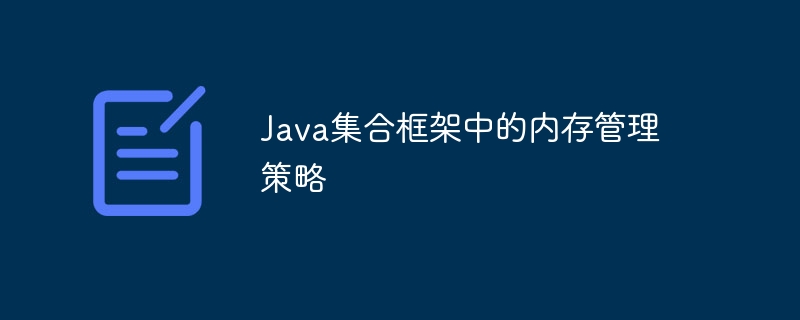
The Java collection framework uses various memory management strategies to optimize performance. These include: Array: stores elements in contiguous memory blocks, suitable for quick addition and deletion, but the size cannot be adjusted. Linked list: A dynamic data structure that stores elements in nodes and can grow or shrink as needed, but adding or deleting is expensive. Hash table: Based on key-value pairs, elements are mapped into buckets through a hash function to achieve fast search, but hash conflicts may occur. Tree: A hierarchical data structure that provides efficient sorting and searching, but insertion and deletion operations are complex and performance is limited when using large amounts of memory.

Memory Management Strategies in Java Collections Framework
Introduction
Java Collections A framework is a set of classes for storing and managing objects. These classes use different memory management strategies to improve performance and efficiency. This article explores the most common memory management strategies used by the Java collection framework.
Array
Array is the simplest memory management strategy. It allocates a contiguous block of memory in memory for storing elements. The advantage of an array is that it can add and remove elements efficiently. However, the size of an array is fixed, meaning it cannot be resized once created.
Linked List
A linked list is a dynamic data structure that stores elements in objects called nodes. Each node contains the element itself and a pointer to the next node. Linked lists can grow or shrink as needed, making them suitable for storing variable numbers of elements. However, adding or removing elements from a linked list requires more overhead because the pointer to a new or empty node needs to be updated.
Hash table
Hash table is a data structure based on key-value pairs. It stores elements in arrays called buckets. Each bucket stores elements with the same key. Hash tables enable fast lookups by using a hash function to map keys to buckets. The advantage of hash tables is that finding and deleting elements is very efficient. However, they can also occur in a situation called hash collision, when two elements hash to the same bucket.
Tree
A tree is a hierarchical data structure that stores elements in nodes. Each node can have multiple child nodes. Trees provide efficient sorting and searching of elements, similar to binary search trees or red-black trees. However, tree insertion and deletion operations can be more complex and have performance issues if large amounts of memory are used.
Practical Case
Suppose we have an application that contains student information. We can use different collection types to store student objects:
Conclusion
The Java collection framework provides a variety of memory management strategies to meet different application needs. Understanding these strategies can help developers choose the right collection type to optimize application performance and efficiency.
The above is the detailed content of Memory management strategies in Java collection framework. For more information, please follow other related articles on the PHP Chinese website!
